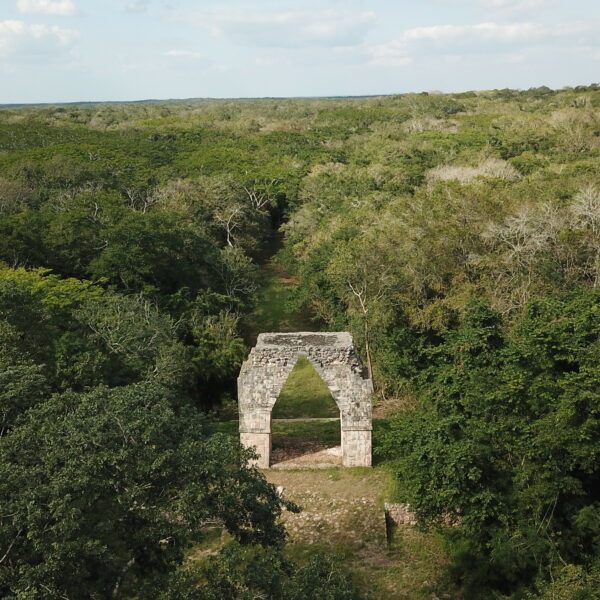Summary
The Sacbe (white road) that connects the cities of Uxmal and Kabah is a pre-Hispanic road that is five meters wide and 18 kilometers long. It was also the means by which the pre-Hispanic cities of Uxmal, Noh Pat, and Kabah were communicated.
Since it was first built, this pre-Hispanic communication route offered rest areas, places to drink and procure water, stone quarries (where its construction materials were extracted), and observation points or watchtowers to monitor traffic. Despite what we know today, there are no full records of this Sacbe.
This proposal’s importance lies in the recovery of the present-day Maya’s identity through integration, appropriation, and economic development activities. These, through community organization and collaborative work, will provide this pre-Hispanic causeway with physical and economic sustainability through management strategies for a group of tourist activities that will involve the majority of Santa Elena residents.
Goals
- To promote and recover the Sacbe’s archaeological features.
- To recover the value of this pre-Hispanic causeway through its care, conservation, and maintenance, which will be carried out by the Santa Elena community.
- To develop strategies for Santa Elena residents to obtain a direct economic benefit from the tourist development of this white road.
Methodology
Through community work strategies, with the support of educational institutions, Mexico’s National Institute for Anthropology and History (INAH) and other specialized agencies, to build initiatives based on the heritage research, care, and conservation that will promote self-sustaining development in Santa Clara, based on the Sacbe.
Benefits
- Ensuring the care and preservation of archaeological heritage.
- Strengthening the integration and appropriation of the Maya culture
- Generating permanent job opportunities for Santa Elena residents.
- Generating knowledge on topics such as the pre-Hispanic economic activities between Uxmal, Noh Pat, and Kabah; the relations between lordships; ways of life; constructive systems; and the uses and interrelationships that existed between these great cities; among others.
- Designing and implementing the Sacbe’s sustainable tourism uses by means of a parallel road which visitors can tour by biking, hiking, or visiting specific sections; this will allow this important pre-Hispanic road to recover some of its value and create a different experience.
- The first activity will be the registration. By means of LIDAR technology, images will be processed to define the road’s archaeological features, which will later be verified through field walks throughout the length and width of the Sacbe.
- Archaeological prospecting; this activity will be carried out along the Sacbe’s topographic survey.
- Environmental impact study before clearing out the pre-Hispanic communication route.
- Carrying out the study to clear the Sacbe, sustainably, and leave bigger trees on the roadsides. This effect is called Tzolche’ in Mayan: a tunnel created by the vegetation.
- Carrying out drilling excavations to determine the temporality and constructive traits, and their relationship with the immediate environment.
- Developing training programs related to the care of heritage, Maya culture, the environment, and the importance of bioculturality.
- Definition of architectural design for topology of routes and service areas.
- Plan for socio-economic development of communities in the region
- Formation of a cooperative managed by the community of Santa Elena, with the necessary regulations for its operation geared towards the enhancement of the Sacbe
- Training for the members of the cooperative in the projects that are aligned with the recovery and enhancement of the Sacbe.
- Service management. The tourism, maintenance and conservation services devoted to the pre-Hispanic road will be under the responsibility of the cooperative formed by Santa Elena residents, with the support of specialists.
- The enhancement of the Sacbe and assurance of its care, maintenance, and sustainability.
- Improvement of the Santa Elena community’s well-being and economic development.
- An evaluation process will be developed for continuous improvement, with the participation of specialists and the community of Santa Elena.
- The project can work in a period of two years, during which the residents of Santa Elena will be participating in the archaeological research, through training and hands-on involvement.
- Twenty-four months, divided in three phases.
- The first, eight months long, will involve office work concerning the planning of the intervention and basic engineering works.
- The second, a four-month phase, will be devoted to training Santa Elena residents.
- The third one, spanning 14 months, will be geared towards the development of architectural, engineering, and archaeological works.
- All initiatives, projects, and activities will feature every mechanism for timely, precise information to donors, and a quick and practical communication mechanism will be established between donors and beneficiaries, in order to have a direct relationship and to be able to assess the results and effectiveness of donations.
- Every initiative, project, and activity will be audited, and its information be made available to donors, upon request, in accordance with the corresponding regulations.
- All the information regarding the initiatives, projects, and actions developed with the support and sponsorship of the Foundation will be available on the Foundation’s website, in accordance with the applicable regulations.
- The results will be announced and disseminated through all the foundation’s electronic channels, website, social networks, as well as a direct communication system via email with donors and any person who requests the information.
- The publication of the results will also be promoted in dissemination journals, mass media, such as newspapers and magazines, and in specialized and specific media, both for dissemination and for academic purposes.

